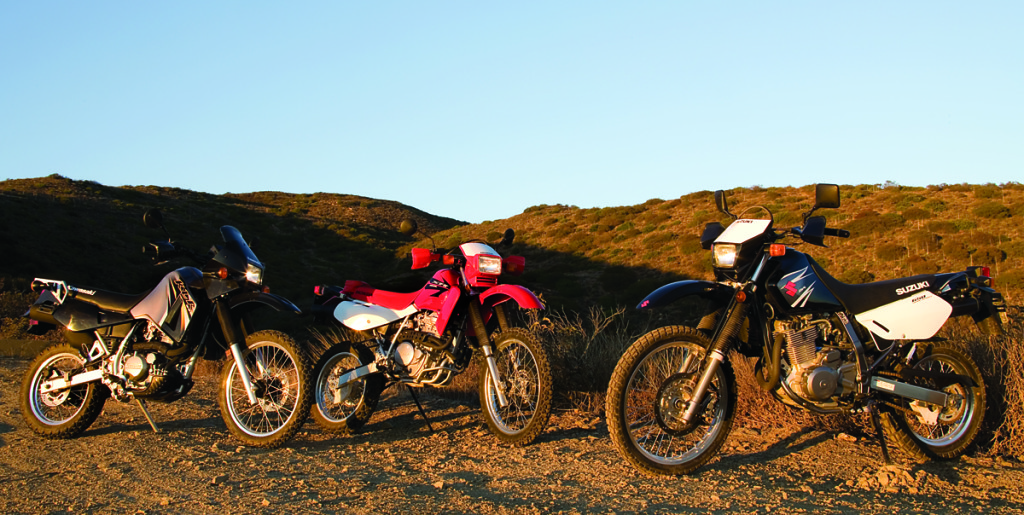
A lot of riders look at these three motorcycles, scratch their heads, and wonder just what they’re meant for. Anybody who desires a good dirt bike can make a choice from a big selection, and a street rider has an even greater variety. Why get one of these machines, these compromises intended for the dual purpose of riding both hard and soft surfaces?
Dual-sporting is a different approach to riding, involving mostly pavement, but a goodly number of hours on dirt roads and trails. Anybody who lives near a national forest or any place that offers miles of dirt roads should become a dual-sport enthusiast. West Virginia’s 500-mile Hatfield-McCoy trail system is a good example of dual-sporting paradise. There are probably a million miles of dirt roads in this country-most of which require a license plate to ride.
These machines all had their genesis back in the ’80s, and have weathered the years quite well. The KLR has been in Kawasaki’s lineup for more than 20 years, and will be getting a major makeover for 2008. They are quite similar, especially in the engines: The three cylinders all have a 100mm bore, while the Honda and Suzuki have an 82mm stroke, the Kawasaki, 83mm. All have single overhead camshafts and four valves per head, and good counterbalancing systems to ward off the vibes.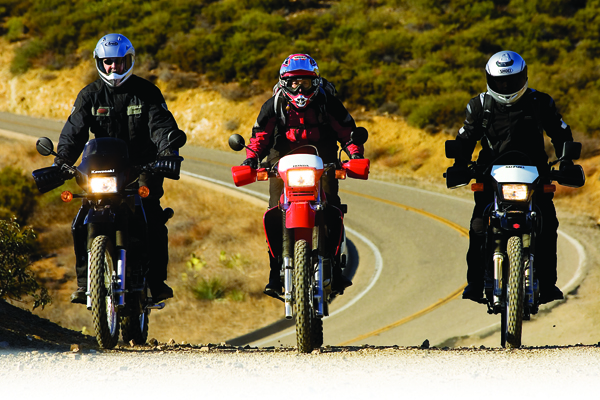
The most important similarity is that all three machines have the 20-pound button-also known as an electric starter. The KLR led the pack with this innovation, doing it on the 600 version in 1984, followed in ’93 by Honda, ’94 for Suzuki. This made all the difference, as the bikes became very user-friendly and could be used as weekend exploring devices or fuel-conscious commuters. They sold in profitable numbers, and since they were involved in neither competitive action nor the chrome and radio wars, they have been pretty much left alone. Tooling costs have long since been amortized, and sales continue at a respectable rate.
How to choose among these three? As one wag put it, the most obvious difference may be that the Suzuki has rectangular rearview mirrors, while the other two have round ones. Riding them, however, one soon becomes aware that the XR was derived from Honda’s dirt bikes, while the DR and KLR grew out of the less serious “playbike” category, an expression popular in the ’80s. None of these bikes would be my choice for a cross-country trip on Interstate 80, but to ride a hundred or more miles on a freeway, at 75 mph, is entirely doable.
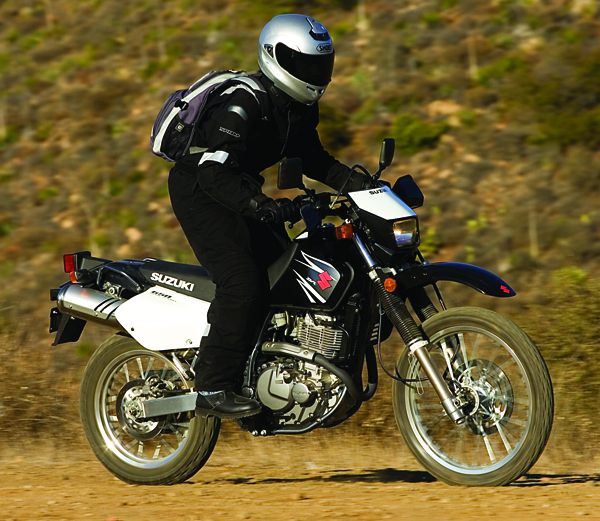
According to the stone simple but precise Rider scale, the wet weights of the Honda and Suzuki are 344 and 368 respectively, while the KLR rides in at 411 pounds. Its additional avordupois can be attributed to its liquid-cooling, requiring a pump and radiator as well as a skid plate to keep from harm the pump that is mounted low at the right front of the crankcase. At 6.1 gallons it is also carrying about 20 pounds more fuel than the 3.4-gallon Suzuki and 2.8-gallon Honda. The DR is air and oil cooled, and has a small oil cooler mounted high up and pretty much out of harm’s way. The Honda is air-cooled, with a dry sump and oil-in-frame, and our California model came with small engine guards to protect the crankcase as well as a great quantity of vulnerable emission-regulating hoses and stuff on the left side of the cylinder.
I mention all this because most dual-purpose machines will find themselves laying on their sides at some point or other in their lives, a result of minor spills on sandy roads or rocky trails. Nobody wants a simple stupidity to ruin the entire day. Pick it up and keep on going. Owners of dual-sports are generally rather benign riders, sensible enough not to push the traction issue, content to take to the dirt surfaces with caution.
All the front wheels are 21-inchers–the dirt-bike standard–and the XR also uses a dirt-worthy 18-inch rear, while the DR and KLR have odd 17-inch rears. The tires are quite different, as the XR comes with rather knobby Dunlop K850s, the KLR with less-aggressive K750s, and the DR with more modest Bridgestone Trail Wings. Every wheel has a single-disc brake, and braking power on the rear wheels comes from single-piston calipers, while on the front both Honda and Suzuki have twin-piston calipers but the KLR suffers along with its single piston. On loose surfaces front brakes are of minor importance, but on the pavement the difference was quite noticeable, and the KLR’s stopping distance does suffer.
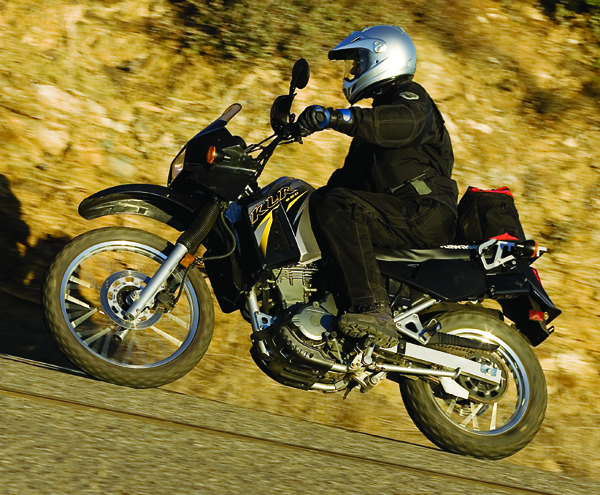
All three engines sit in cradle frames, with leading-axle front forks and single-shock rear suspensions. Saddle heights go from the Honda’s nose-bleed 37 inches to the Kawi’s 35 and Suzie’s 34.8 inches, which can be lowered to 33.2 inches with modifications performed by a dealer. It is still a major lift to get a leg over any one of these. The DR’s footpegs are the lowest and farthest forward, the XR’s are the highest and farthest back-creating minor ergonomic differences.
Suspension adjustability varies. The XR’s is the most easily manipulated, as the 43mm fork has air-adjustable preload and adjustable compression damping, while the shock comes with full adjustability; each end offers 11 inches of travel. The KLR’s 38mm fork is air-adjustable, the shock has preload and rebound-damping adjustments, and there’s more than 9 inches of travel at both ends. The DR has a non-adjustable 43mm fork, with spring preload and compression damping adjustments on the shock, and over 10 inches of travel; if one opts for a lower seat height on the DR, suspension travel drops to 8.7 inches. On the frosting side all three come with suitably minimalist toolkits and helmet locks. The KLR also has a useful luggage rack. Gas mileage varied from 38 mpg on the KLR, to 39 on the XR, and 45 on the DR.
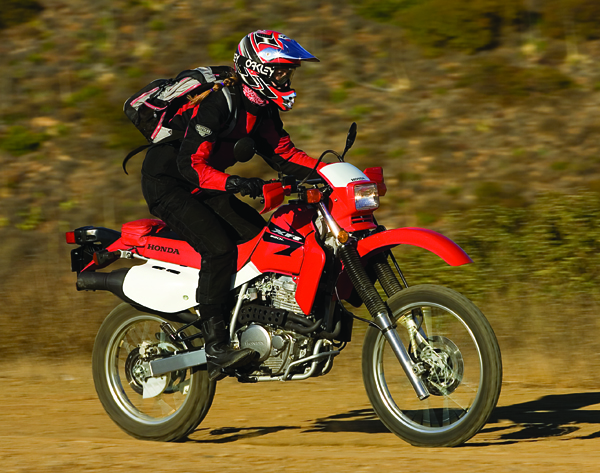
On the dirt roads of California’s Santa Lucia mountains, our testing ground, the XR certainly felt most at home, with the steepest steering, highest seating and most suspension travel-almost like riding a dirt bike. Its footpeg placement made it easy to stand up when charging into some rough stuff, though at 6 feet, 3 inches, I find myself a bit too tall to look graceful doing this on-the-pegs routine. It’s your choice if offroad capability is of primary importance. The DR suffers from its soft suspension, and what seems to be less low-end torque from the engine, although it was quite content to poke along at a moderate pace. Its street-oriented tires are not very useful in steep uphill scrabbles, and fortunately we did not have to traverse any deep sand. In the middle was the KLR, with its strong torque, decent tires and middling suspension travel.
On the pavement the KLR was king, with its big gas tank, comfiest seat, a tachometer (7,500 redline) and the biggest of wind deflectors. It would probably be the bike of choice for anybody heading from Alaska to Argentina. The DR was second-best onroad, and had the least vibration, in part due to its bar-end weights. This machine retains most of that original “playbike” aspect, an all-around entertainment without any serious off-road pretensions. The XR could not have cared less about its status on the asphalt; it just wanted to get to the next dirt road.
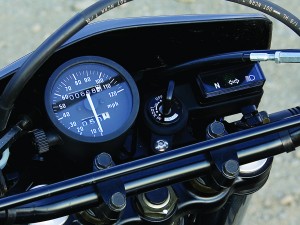
With prices all in the $5,000-$6,000 range, you pays your money and you takes your choice. And your choice may depend on several things. How much dirt-roading you plan on doing-10, 20, 30 percent of your miles? Or the length of your inseam. Overall the KLR seems to be the best compromise among a trio of compromises, as it offers good power, the most range and comfort and some offroad capability.
A couple of notes: We would like to have included the $7,500 BMW F650GS in this test, but BMW said not a one was available. And if you are wondering about the aftermarket for these dual-purpose bikes, it is HUGE–everything from bigger gas tanks to pannier bags to suspension mods to whatever you can think of–let your computer do the walking. In the interest of full disclosure, it should be noted that I own an essentially stock DR, the only change being a bigger 4.9-gallon IMS gas tank, and that Editor Tuttle has a fully “adventurized” KLR which could cheerfully carry him to the tip of South America.

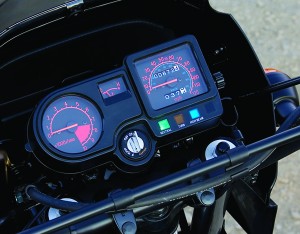
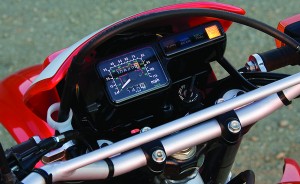







Yeah for the KLR!
Love the Honda above them all, but for long distance highway trips, its cooling system based on water is better.
The DR seems to be a de tu ed KLR. And the Honda is the best for its light weight and nimbleness. But, highway demands better cooling systems, so I have to go for the second best (I will use it 50/50)
My plan is to get the heavy, but more durable (engine likes good cooling, hope Honda brings back its “TransAlp” series) KLR , but I will get better suspension.
A KLR wih taller rear suspension, heftier, and longer 43 front suspension wit at least 11 in travel will do.
Any comments on suspension upgrades for the KLR ?
What’s up with magazine scales ? Over the decades I’ve read a ton of test reports on the KLR650, and the wet weights for the Gen 1 have ranged from 398 to the 411 seen here. I saw one at 407, but most said 401. The Gen 2 has been reported to between 420 to 440 wet, with 432 the most common number. I’ve read the weight of gas varies, which could account for some of the difference, and California models might weigh a bit more or less than 49 state models, but still….